What Are Pvc Pipe Fittings?
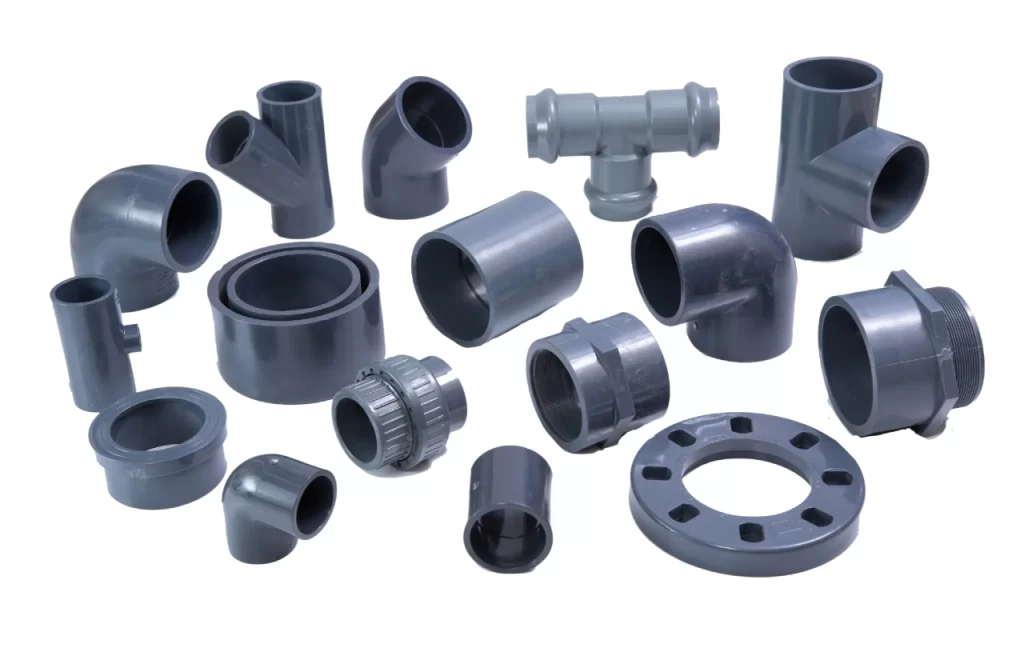
PVC pipe fittings come in many shapes. Before we delve into them, we need to understand what a faucet is. A fitting is a removable pipe that connects two pipes or hoses. Fittings are applied in mechanical and plumbing work.
PVC is an abbreviation of Polyvinyl Chloride, which is a cheap and easy-to-process material. PVC pipe is a commonly gray pipe used for water supply and removal. This can be dirty or clean water. PVC pipe fittings are also used to pull electrical cables so they are not hanging or exposed on the wall or floor somewhere. PVC resin is a type of plastic, and PVC pipe fittings are the small pieces that are used to connect pipes made from this resin.
PVC pipes and fittings are also called connectors. Fittings may be crafted from numerous substances and range through manufacturers.
Different types of PVC pipe fittings have their own applications and uses. Each customization has a different number of iterations and uses. PVC pipes and fittings can be broadly divided into two categories.
- Sanitary grade connectors – used in sanitary drainage and sewage systems
- furniture grade connectors
What Are The Different Types Of Pvc Fittings?
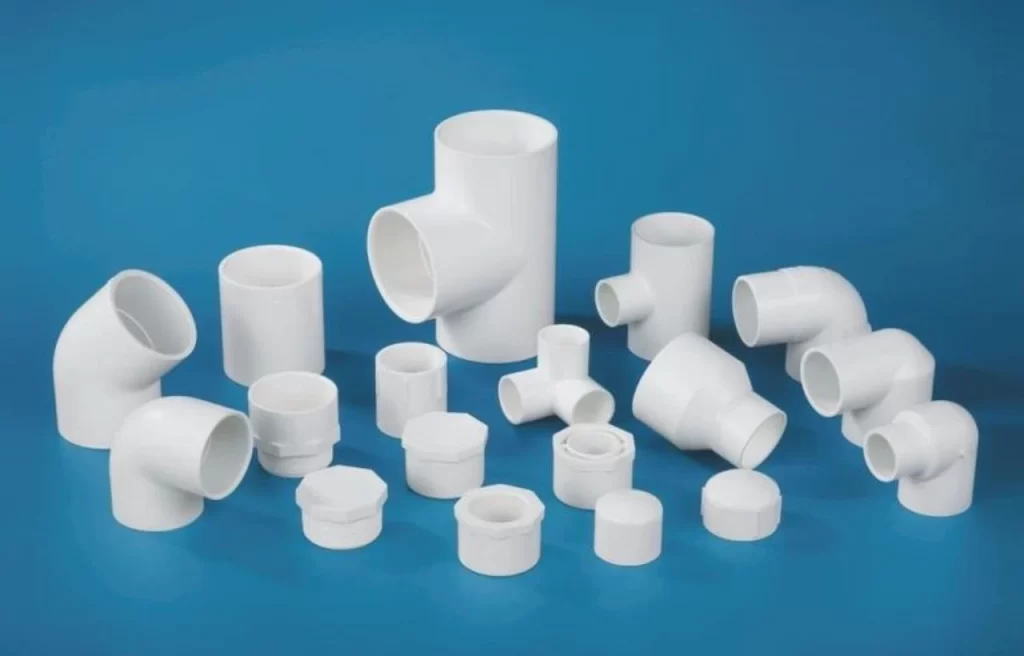
Below is a list of some of the most common types of PVC pipe fittings on the market.
Tees
The PVC Tee is a 3-end fitting. Two on a straight line and one on the side at a 90-degree angle. A tee allows him to split the line into two separate lines with a 90-degree connection. A tee can also connect two lines to one main line. It is also often used in PVC construction. A tee is a very versatile fitting that is one of the most common types of PVC pipe fittings that are used in plumbing. Most tees have socket ends, but threaded versions are also available.
Elbow
If the piping system is to be twisted or bypassed along the way, the piping must be bent with its PVC bends. Elbows are most commonly available in 90-degree and 45-degree angles, allowing you to orient your pipe any way you like. Side bends are a slightly different part and are often used as corners in projects such as canopies, tents, displays, and crates. They have three ends instead of two. Most elbows have socket ends, but threaded versions are also available.
Cross
A cross is a somewhat unusual type of PVC pipe fitting that connects four sections of pipe. It has four sliding joints (S x S x S x S) that meet at 90-degree angles to form a “plus” shape. PVC cross fittings are commonly used when building frames out of PVC pipes. Crosses can add a lot of structural integrity to a framework. It can also be used to split the liquid flow into different directions.
Coupling And Connection
Couplings are one of the simplest (and cheapest) types of PVC pipe fittings. They are small parts that connect or “join” one part to another and are usually used permanently. You can connect pipes to pipes and pipes to fittings. Some of them can shrink and connect smaller pipes to larger ones and vice versa. Couplings are available with slip or internally threaded ends as required.
Connections connect things like couplings, but they are not permanent solutions that can be easily taken apart. PVC connectors are commonly used to build temporary structures such as tent supports, which can be dismantled when the structure is no longer needed. There is a ring in the middle that separates the two ends for easy disassembly and maintenance.
Cap And Plug
The cap have a very simple job: stop the flow. They are placed at the end of a pipeline that doesn’t need to connect to another pipe. You can stop pipelines that grow later, or make your system easily accessible when you need it. It can also give pipes in PVC construction projects a finished look. Caps can have either socket or female ends as they are placed around or outside the
PVC Pipe Fittings
A plug is similar to a cap, but instead of stopping flow in a pipe, it stops flow in a fitting. Due to this, the plug goes into the fitting. This means it has either a spigot or an external thread.
Adapter (Female And Male)
Adapters, sometimes called reducing couplings, are versatile. These PVC pipe fittings are designed to change the pipe end type to work with different sizes of PVC pipes and fittings. They can have threaded or socket ends to connect to an endless variety of PVC pipes and fittings. Adapters are either male or female, socket or spigot.
Bushings
Bushings are very similar to adapters but focus on connecting pipes of different diameters by reducing PVC pipe fittings. (Sockets cannot be reduced to the pipe.) Bushings are also usually threaded, which distinguishes them from other types of fittings. This allows for different types of connections and makes pipelines easier to maintain and customize. Bushings are commonly used in landscaping and aquaculture because they are more water-friendly than hardware that can rust.
Nipple
In PVC systems he may need to join two female ends together. The fitting for this job is the nipple. A nipple is a fitting that has male ends. Such PVC pipe fittings need to be a tight fit and are most commonly made of Schedule 80 PVC. However, it is compatible with the planned 40 parts.
Flanges
Flanges are metal fittings for attaching accessories to pipes. It can also increase the strength of the pipe. The most common type of flange is at the bottom of the toilet. A flange is a bolt, clamp, edge, or disc-like joint that creates a seal by pressing two surfaces together with a compressive force. However, most flanges use bolts to connect the two sides. PVC flanges are available with slip or threaded ends. Due to the required strength of the flange, it is usually made of Schedule 80 PVC.
What Are Hydraulic Fittings?
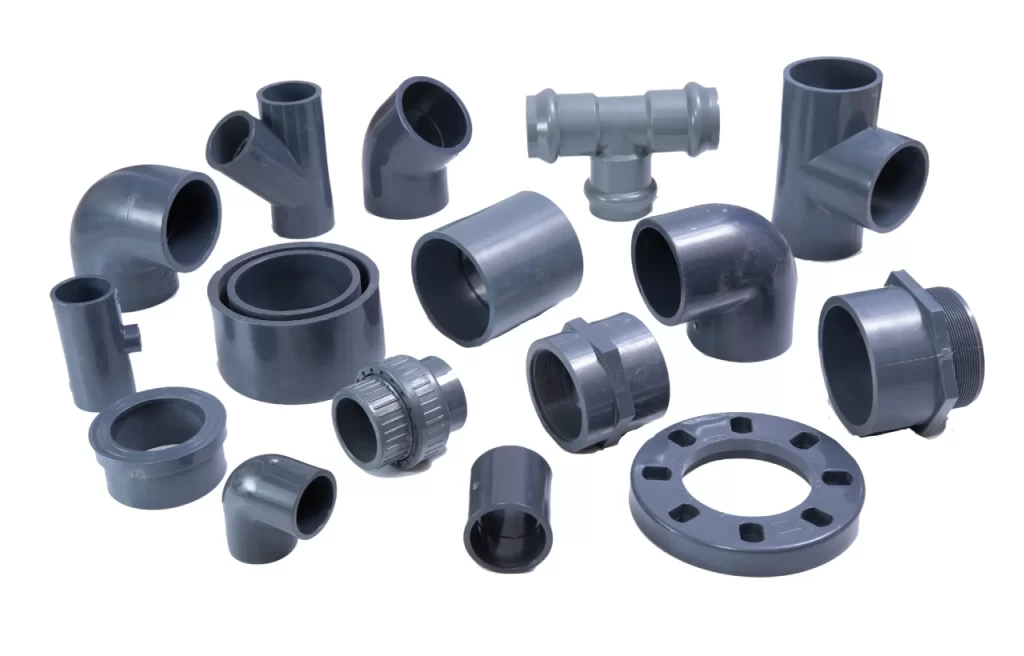
Hydraulic systems require high fluid pressure, such as hydraulic actuators in excavators and bulldozers. PVC pipe fittings used in hydraulic systems are designed to withstand high pressures not present in typical piping systems. For this reason, they are not compatible with fittings used in standard piping. Hydraulic fittings withstand sudden failures and high-pressure leaks.
Hydraulic Fittings Used For
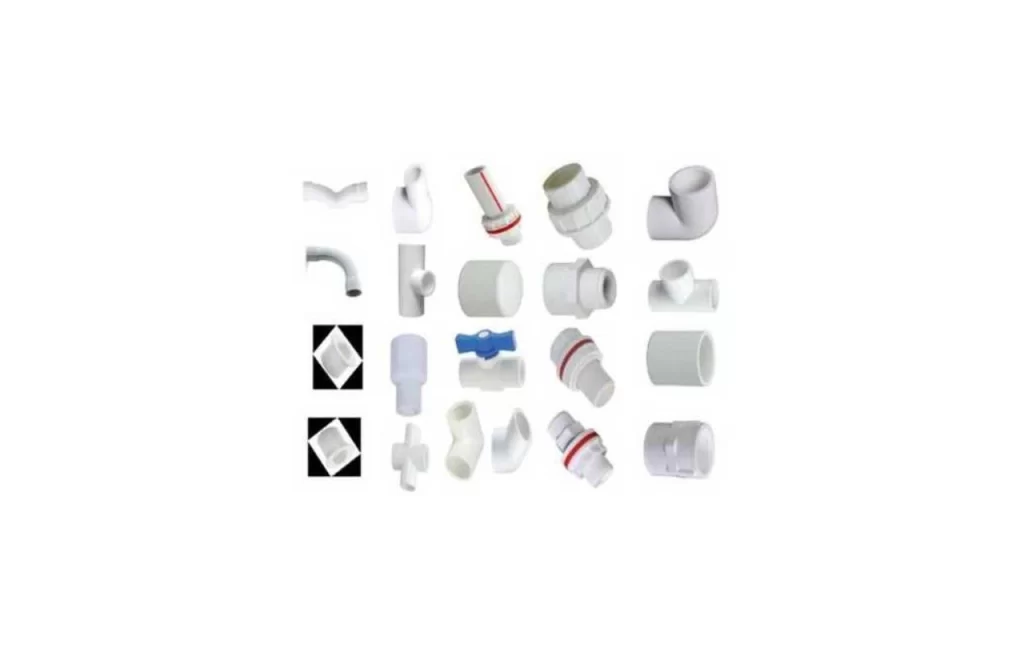
Hydraulic fittings connect conductors such as hoses, tubes, and pipes in hydraulic systems. Most PVC pipe fittings have male and female components that connect to form a union. These connections help contain and direct the flow of hydraulic fluid within the conductor while preventing leaks and maintaining pressure. Various PVC pipes and fittings allow the designer to change the flow direction, pipe height, or flow division. Crimping is the maximum not unusual place approach to assembling hoses and fittings. Once the specific hose and fitting crimp specifications are confirmed, the crimp machine is set to the appropriate crimp diameter setting. The next step is to lubricate the fitting, put it on the end of the hose and insert it into the crimp machine.
Hydraulic Fittings are made from a variety of materials including stainless steel, brass, plastic, and more. Often, but not always, the fitting matches the conductor material used in the system. This variety of materials creates hardware with a wide range of performance capabilities. Most hydraulic PVC pipes and fittings have pressure and temperature ratings, size, and dimensional standards.
What Is DWV PVC Pipe Fittings
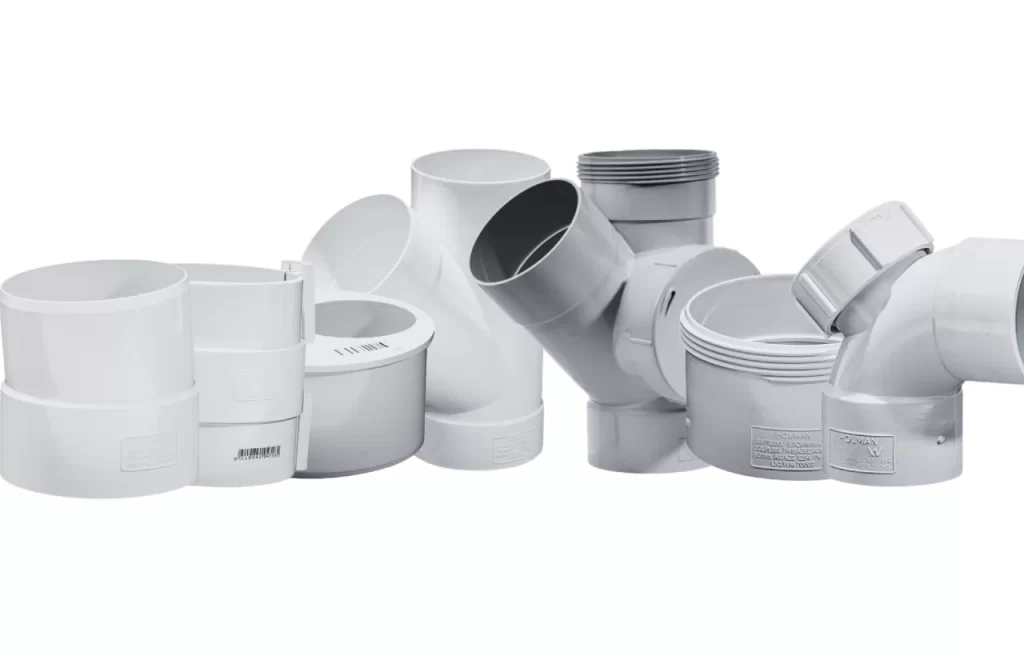
DWV system stands for Drain-Waste-Vent-System. It involves transporting wastewater from plumbing equipment such as toilets, bathtubs, showers, dishwashers, and washing machines in the home to the urban sewage system.
The system consists of a series of DWV pipes, cleaning ports, siphons, fittings, and vents that keep sewage gases from entering the home while allowing wastewater to flow freely.
The two most common types of DWV pipe are PVC and ABS. DWV PVC pipe fittings are made of PVC or polyvinyl chloride and are the most common type of DWV pipe. ABS DWV tubing is made from ABS or acrylonitrile butadiene styrene and is less common.
The PVC pipes and fittings operate at low pressure and rely heavily on gravity to allow smooth fluid flow. DWV PVC pipe fittings are found in drain sewage vent systems and have a smooth interior to keep dirt from sticking to the surface. They are typically found in underground piping systems, groundwater treatment systems, or stormwater treatment systems.
- Slip joint fitting
- cabinet flange
- Sweep elbow
- Trap primer
- Clean-out
- Plumbing tee
- Baffle tee
- Combo tee
- Sanitary cross or double sanitary tee
PVC Pipe manufacturing is a process that involves the creation of pipes made from PVC resin. This type of pipe is used in a variety of applications, including sewer and drainage systems, water mains, and irrigation lines.
Different Sizes Of Pvc Fittings?
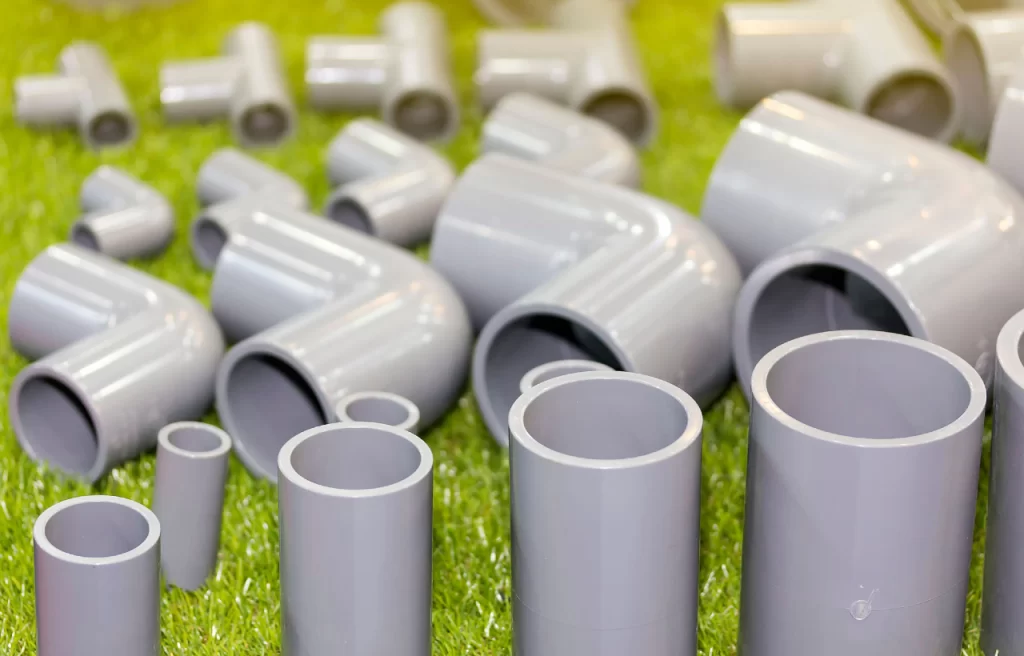
It Depends on your project If you are purchasing new PVC pipe and fittings. PVC pipe fittings come in different pipe sizes and fall into three main categories: Schedule 40, Schedule 80, and Schedule 120. To avoid misuse, line failures, or plumbing project delays, we can help you find the right product to do the research and fit. It will save you and your team time and money when you need to reorder materials or troubleshoot future pipe problems.
PVC pipes and fittings are measured on a nominal system. This means that all measurements are based on the type of construction for a particular measurement. For example, 0.84 inches measured from one end of a pipe to the other would classify as a 1-inch pipe. Also, each PVC pipe fittings have different uses. Read on to understand the different pipe sizes and uses of each PVC pipes and fittings for your next job.
| Your Measurement | Average Outer Diameter (OD) |
| Diameter | PVC Pipe Size Translation |
| 0.84” | ½” |
| 1.05” | ¾” |
| 1.315” | 1” |
| 1.66” | 1 ¼” |
| 1.9” | 1 ½” |
| 2.375” | 2” |
| 3.5” | 3” |
| 4” | 3 ½” |
| 4.5” | 4” |
| 5.563” | 5” |
| 6.625” | 6” |
| 8.625” | 8” |
| 10.75” | 10” |
| *It’s Available for Schedule 40 and Schedule 80 PVC pipe Fittings. | |
How are PVC fittings labeled?
Pipe fittings PVC, commonly used in plumbing systems, play a crucial role in ensuring the proper connection and functionality of fittings for PVC pipes. These fittings are labeled in a standardized manner to provide essential information for users, making it easier to select the appropriate fitting for specific applications. The labeling of PVC Plumbing fittings typically includes important details such as size, type, and relevant standards. One of the key aspects of Plumbing PVC pipe fittings labels is the size designation. PVC fittings come in various sizes, and their labeling usually includes measurements such as diameter or nominal size. This information is crucial for matching the fitting with the corresponding PVC pipe size, ensuring a secure and leak-free connection. The type of fitting is another vital element found on labels of fittings for pvc pipe. Different types of fittings are available to accommodate specific plumbing requirements, such as elbows, tees, couplings, adapters, and more. The label indicates the specific type of fitting, allowing users to choose the one that suits their plumbing system layout and design. Furthermore, Pipe fitting PVC labels often mention the relevant standards or certifications that the fittings comply with. This ensures that the fittings meet specific quality and safety requirements, providing peace of mind to users and ensuring compatibility with other plumbing components. In the realm of plumbing PVC pipe fittings, clear and accurate labeling is essential. It enables plumbers, contractors, and even DIY enthusiasts to identify the right fitting for their projects, ensuring proper installation and optimal performance of the plumbing system. Whether it’s for residential, commercial, or industrial applications, understanding the labeling of Pipe fittings PVC is crucial for maintaining efficient and reliable plumbing systems.
How Much Length Do Pvc Fittings Add?
Pipe fittings PVC are an integral part of plumbing systems, used to connect PVC pipes and create a reliable and secure network. When incorporating pipe fittings pvc into a plumbing project, it’s important to consider the additional length they add to the overall pipe assembly. The length added by PVC fittings depends on several factors, including the type of fitting and its dimensions. Plumbing Pvc Pipe Fittings are available in various shapes and sizes, such as elbows, tees, couplings, and adapters, each with its own specific design and dimensions. The length added by a fitting can vary based on its configuration and purpose. For example, an elbow fitting, which is used to change the direction of the pipe, typically adds more length compared to a simple coupling that joins two straight pipe sections. The length added by Pipe fittings PVC is primarily due to their socket depth, which is the length of pipe that can be inserted into the fitting. The socket depth varies depending on the fitting size and type. Generally, larger fittings tend to have deeper sockets, resulting in a greater added length. It’s important to note that the added length is typically measured from the end of the pipe to the face or end of the fitting. To ensure accurate measurements and proper planning, it is recommended to consult manufacturer specifications or reference tables that provide information on the added length for different Pipe fittings PVC. This allows plumbers, contractors, or DIY enthusiasts to account for the additional length and make precise calculations for pipe layout, cut lengths, and overall system design. Considering the added length of fittings for pvc pipe is essential to avoid miscalculations and ensure the proper fit and alignment of pipes in a plumbing project. By accounting for the added length, it becomes easier to plan and execute plumbing installations efficiently and effectively.
How Much Do Pvc Pipe & Fittings Cost?
The cost of pipe fittings PVC can vary depending on several factors such as the size, type, brand, location, and supplier. PVC (Polyvinyl Chloride) pipes and fittings are commonly used in plumbing systems due to their durability, affordability, and ease of installation. When it comes to pricing, PVC pipes are usually sold in standardized lengths, such as 10 feet or 20 feet. The cost of pipe fittings pvc is primarily determined by their diameter (or nominal size), with larger diameter pipes generally being more expensive than smaller ones. Additionally, the thickness of the pipe walls, known as the schedule, can also affect the price. Fittings for pvc pipe, on the other hand, are available in various types and sizes to accommodate different plumbing needs. The cost of fittings for pvc pipe varies depending on the complexity of their design and functionality. Simple fittings like couplings and adapters are generally less expensive compared to more specialized fittings like tees, elbows, or valves. To provide a general idea of pricing, the cost of fittings for pvc pipe can range from a few dollars for small diameter pipes (e.g., 1/2 inch) to several hundred dollars for larger diameter pipes (e.g., 6 inches or more). PVC fittings, depending on their type and size, can cost anywhere from a few cents to several dollars each. It’s worth noting that prices may also vary depending on the location and supplier. Local hardware stores, plumbing supply shops, and online retailers are common sources for purchasing plumbing pvc pipe fittings. Comparing prices from different sources and considering any additional costs like shipping or taxes can help in finding the best deal. Overall, plumbing pvc pipe fittings offer a cost-effective solution for plumbing needs, allowing for efficient and affordable installations. It’s recommended to research local prices, consult suppliers, and consider project requirements to determine the most accurate and up-to-date pricing for PVC pipes and fittings.
What Are Common Types Of Pvc Pipes & Fittings?
PVC (Polyvinyl Chloride) pipes and fittings are widely used in plumbing systems due to their durability, affordability, and ease of installation. They offer a versatile solution for various plumbing applications. Here are some common types of PVC pipes and fittings:
1. PVC Pipes: Pipe fittings pvc come in different sizes and schedules (wall thickness). They are used for water supply, drainage, irrigation, and venting purposes. Common types include PVC Schedule 40 and PVC Schedule 80 pipes.
2. PVC Elbows : Elbows are fittings used to change the direction of the pipe. PVC elbows are available in various angles, such as 45 degrees and 90 degrees, and are commonly used to navigate around obstacles or create turns in the plumbing system.
3. PVC Tees:Tees have three openings and are used to create a branch in a plumbing system. They allow for connections at right angles and enable the flow to be split into two separate directions.
4. PVC Couplings: Couplings are Pipe fittings pvc used to connect two pipes of the same size together. They provide a secure and leak-free joint and are commonly used in straight pipe connections.
5. PVC Adapters: Adapters are used to connect fittings for pvc pipe to different types of pipes or fixtures. They allow for a transition between PVC and other materials, ensuring compatibility and easy installation.
6. PVC Caps: Caps are used to seal the end of a PVC pipe, preventing the flow of fluids. They are commonly used in situations where a pipe does not require a connection but needs to be closed off.
7. PVC Valves: PVC valves are used to control the flow of water or other fluids in a plumbing system. They come in various types, including ball valves, gate valves, and check valves, providing options for different control and shutoff functionalities.
These are some of the common types of plumbing pvc pipe fittings used in plumbing systems. They offer flexibility, durability, and ease of use, making them a popular choice for a wide range of plumbing applications. The availability and selection of plumbing pvc pipe fittings may vary based on the specific requirements of the plumbing project.
What Are The Names Of Pvc Fittings?
PVC (Polyvinyl Chloride) pipes and fittings are widely used in plumbing systems due to their versatility, durability, and cost-effectiveness. There are various types of PVC pipes and pipe fittings PVC available to accommodate different plumbing needs. Here are some common types:
1. PVC Pipes: pipe fittings PVC come in different schedules (wall thickness) and are available in various sizes (diameters). They are typically used for water supply, drainage, irrigation, and venting applications.
2. PVC Couplings : Couplings are used to connect two pipes of the same size together. They provide a secure and leak-free joint and are commonly used in straight pipe connections.
3. PVC Elbows:plumbing pvc pipe fittings that allow for directional changes in plumbing systems. They come in different angles, such as 45 degrees and 90 degrees, and are used to navigate around obstacles or create turns in the pipe layout.
4. PVC Tees:Tees have three openings and are used to create a branch in the plumbing system. They allow for the connection of two pipes at a right angle while maintaining a third opening for another pipe or fixture.
5. PVC Adapters:Adapters are fittings used to connect pipe fittings PVC to different types of pipes or fixtures, such as metal pipes or faucets. They provide a transition between different materials or sizes.
6. PVC Caps:plumbing pvc pipe fittings Caps are used to seal the end of a PVC pipe. They are commonly used in situations where a pipe does not require a connection but needs to be closed off.
7. PVC Valves:PVC valves are used to control the flow of water or other fluids in a plumbing system. They come in different types, including ball valves, gate valves, and check valves, providing options for different control and shutoff functionalities.
These are just a few examples of the common types of plumbing pvc pipe fittings used in plumbing systems. The wide range of available fittings allows for flexible and efficient installations, catering to various plumbing configurations and requirements.
How Many Types Of Pvc Fittings Are There?
There is a wide range of PVC (Polyvinyl Chloride) fittings available to suit various plumbing needs. These fittings are designed to provide secure and leak-free connections between PVC pipes and fixtures. While the exact number of types may vary, here are some common categories of plumbing pvc pipe fittings:
1. Couplings:Couplings are used to connect two pipes of the same size together in a straight line.
2. Elbows : Elbows allow for directional changes in plumbing systems. Plumbing pvc pipe fittings come in different angles, such as 45 degrees and 90 degrees, and facilitate turns in the pipe layout.
3. Tees:Tees have three openings, allowing for the connection of two pipes at a right angle while providing a third opening for another pipe or fixture.
4. Reducers: Reducers are used to connect pipes of different sizes together. They enable a smooth transition from a larger diameter pipe to a smaller one or vice versa.
5. Adapters:Adapters provide a transition between plumbing pvc pipe fittings and other types of pipes or fixtures, such as metal pipes or faucets. They allow for compatibility and connection with different materials or sizes.
6. Caps:Caps are used to seal the end of a PVC pipe, providing a closure and preventing the flow of fluids.
7. Valves:PVC valves control the flow of water or other fluids in a plumbing system. They come in various types, including ball valves, gate valves, check valves, and more, offering different control and shutoff functionalities.
8. Wyes:Wyes, also known as Y-fittings, have a Y-shaped configuration with three openings. They allow for the connection of two pipes at an angle while providing a third opening for another pipe or fixture.
9. Crosses:Cross fittings for pvc pipe have four openings, providing connections for four pipes in a cross shape. They are used when branching multiple pipes in a plumbing system.
These are just some of the common types of fittings for pvc pipe available. Each type serves a specific purpose in plumbing systems, offering flexibility and versatility for various installations.
How Many Types Of Pipe Fittings Are Used In Construction?
In construction, a wide variety of pipe fittings are used to connect and control the flow of fluids within a system. These fittings ensure the proper functioning and efficiency of plumbing and piping networks. While the specific types of fittings can vary depending on the application and materials used, here are some common types of pipe fittings used in construction:
1. Elbows:Elbows are fittings used to change the direction of the pipe, typically at a 45-degree or 90-degree angle. They allow pipes to navigate around obstacles and create bends in the plumbing system.
2. Tees : Tees have three openings and are used to create a branch in a piping system. They allow for connections at right angles, enabling the flow to be split into two separate directions.
3. Reducers:Reducers are used to connect pipes of different diameters together, allowing for a smooth transition from a larger size to a smaller one or vice versa.
4. Couplings:Couplings are fittings that join two pipes of the same size together. They provide a secure and leak-free connection, allowing for easy assembly and disassembly.
5. Adapters:Adapters are used to connect pipes of different materials or sizes. They enable the transition between different types of pipes or fixtures, ensuring compatibility and proper installation.
6. Caps:Caps are used to seal the end of a pipe, preventing the flow of fluids. They are commonly used in situations where a pipe does not require a connection but needs to be closed off.
7. Valves:Valves control the flow of fluids within a system. There are various types of valves, including ball valves, gate valves, butterfly valves, and globe valves, each with its own specific mechanism and functionality.
8. Flanges:Flanges are used to connect pipes, valves, or equipment to form a secure and leak-proof joint. They are commonly used in large-scale construction projects and industrial applications.
These are just a few examples of the types of pipe fittings commonly used in construction. The selection of fittings depends on the specific requirements of the project, the type of pipe material being used, and the desired functionality of the plumbing or piping system.
How Many Types Of Pvc Plumbing Fittings?
There is a wide variety of PVC (Polyvinyl Chloride) plumbing fittings available to meet different requirements in plumbing systems. These fittings are specifically designed for use with PVC pipes and are commonly used in residential, commercial, and industrial plumbing applications. While the exact number of types may vary, here are some common categories of PVC plumbing fittings:
1. Elbows:Elbows allow for directional changes in plumbing systems. They come in various angles, such as 45 degrees and 90 degrees, and are used to navigate around obstacles or create turns in the pipe layout.
2. Tees : Tees have three openings, enabling the connection of two pipes at a right angle while providing a third opening for another pipe or fixture. They are commonly used in branching or distribution applications.
3. Couplings:Couplings are used to join two pipes of the same size together in a straight line. They provide a secure and leak-free connection and are commonly used for extending or repairing existing pipe sections.
4. Reducers:Reducers are used to connect fittings for pvc pipe of different diameters together. They allow for a smooth transition from a larger size to a smaller one or vice versa, ensuring compatibility between different pipe sizes.
5. Adapters:Adapters are fittings used to connect pipe fittings pvc to other types of pipes or fixtures, such as metal pipes or faucets. They provide a transition between different materials or sizes, allowing for versatile plumbing installations.
6. Valves:PVC valves control the flow of water or other fluids in a plumbing system. They come in various types, including ball valves, gate valves, check valves, and more, offering different control and shutoff functionalities.
7. Caps: Caps are used to seal the end of a pipe fittings pvc, preventing the flow of fluids. They are commonly used in applications where a pipe does not require a connection but needs to be closed off.
8. Traps: Traps are fittings used in drain systems to prevent the backflow of gases and odors. They are commonly used under sinks, bathtubs, and other plumbing fixtures.
9. Flanges:Flanges are used to connect pipes, valves, or equipment to form a secure and leak-proof joint. They are commonly used in larger plumbing applications, such as industrial settings or high-pressure systems.
These are some of the common types of PVC plumbing fittings used in various plumbing systems. The selection of fittings depends on the specific needs of the plumbing project, including pipe size, layout, and intended functionality. It is important to choose fittings that meet the required standards and provide reliable connections for a leak-free and efficient plumbing system.
How Long Will Pvc Last In Sun?
The lifespan of PVC coatings when exposed to sunlight can vary depending on a variety of factors such as the type of PVC used, the intensity of sunlight, and the environmental conditions. In general, PVC coating on metal are known for their durability and resistance to weathering, but prolonged exposure to sunlight can cause them to degrade over time. Most high-quality PVC coatings are designed to resist fading, cracking, and peeling when exposed to sunlight for several years. However, exposure to ultraviolet (UV) radiation can accelerate the aging process and reduce the lifespan of PVC coating on metal. To extend the life of PVC coatings, it is recommended to apply a UV-resistant topcoat or store the coated item in a shaded area. In summary, PVC coatings can last several years when exposed to sunlight, but prolonged exposure to UV radiation can cause them to degrade over time. To extend the lifespan of PVC coatings, it is important to take proper precautions such as using a UV-resistant topcoat and storing items in a shaded area.
Does Pvc Coated Metal Rust?
PVC coating is a popular method of protecting metal from rust and corrosion. The PVC coating provides a barrier between the metal and the surrounding environment, preventing moisture and other corrosive substances from coming into contact with the metal surface. As long as the PVC coating on metal remains intact and is not damaged or scratched, the underlying metal should be protected from rusting. However, if the PVC coating on Metal is damaged or compromised, the metal surface can become exposed to the elements and begin to rust. It is important to note that PVC coatings are not completely foolproof and can deteriorate over time due to exposure to UV radiation, extreme temperatures, and other factors. To ensure maximum protection against rust and corrosion, it is recommended to regularly inspect PVC-coated metal surfaces for any signs of damage and to promptly repair or replace damaged coatings as needed.



Leave a Reply